Working as a school librarian during two previous pandemics—H1N1 and SARS—I noticed how students with a science bent were fascinated and eager to learn more. One young man who wanted to become a doctor lit up as he talked to me about wanting to someday heal people. I wonder what he and others like him are doing now: How has the current crisis in so many hospitals affected young people with similar interests and ambitions? What would they like to know? And what about teens who haven’t thought much about these topics before—those who may feel even more bewildered, disoriented, and fearful, especially given the mixed—often contradictory—messages they are hearing from adults?
Many parallels have been drawn between COVID-19 and the 1918 influenza, making it a particularly timely subject to read about—one that shows the strength of the human spirit in the face of terrible adversity and the parallels between efforts to contain it and present-day measures. Below are some highly informative works for teens that provide an excellent overview of events from just a century ago, as well as titles on related subjects.
 Albert Marrin’s Very, Very, Very Dreadful: The Influenza Pandemic of 1918 (Knopf, 2018) offers a detailed account of the origins, global spread, and impact of the terrible virus. This multifaceted work puts events into context, from conditions in the trenches of World War I to the limitations of past scientific knowledge to the avian flu of the late 20th century. The Kirkus review stated, “Not one to shy away from unnerving details, Marrin relays what researchers and scientist express today: another influenza pandemic will unquestionably strike again.”
Albert Marrin’s Very, Very, Very Dreadful: The Influenza Pandemic of 1918 (Knopf, 2018) offers a detailed account of the origins, global spread, and impact of the terrible virus. This multifaceted work puts events into context, from conditions in the trenches of World War I to the limitations of past scientific knowledge to the avian flu of the late 20th century. The Kirkus review stated, “Not one to shy away from unnerving details, Marrin relays what researchers and scientist express today: another influenza pandemic will unquestionably strike again.”
 Readers who enjoy historical fiction will be well served by A Death-Struck Year by Makiia Lucier (HMH Books, 2014). Although it takes place during the 1918 influenza pandemic, many of the challenges the characters face will seem eerily familiar. Cleo, the protagonist, at first feels remote from events taking place on the East Coast, far from her Portland, Oregon, home. But soon her school is quarantined, and places where people normally congregate are closed down. This young woman from a privileged background faces a difficult decision: Stay put and wait to see what happens, or put her own life on the line by volunteering with the Red Cross?
Readers who enjoy historical fiction will be well served by A Death-Struck Year by Makiia Lucier (HMH Books, 2014). Although it takes place during the 1918 influenza pandemic, many of the challenges the characters face will seem eerily familiar. Cleo, the protagonist, at first feels remote from events taking place on the East Coast, far from her Portland, Oregon, home. But soon her school is quarantined, and places where people normally congregate are closed down. This young woman from a privileged background faces a difficult decision: Stay put and wait to see what happens, or put her own life on the line by volunteering with the Red Cross?
 A recent graphic novel, The Invisible War: A World War I Tale on Two Scales by Ailsa Wild, Jeremy Barr, Gregory Crocetti, and Briony Barr and illustrated by Ben Hutchings (Graphic Universe, 2019) is superbly evocative and imaginative. The flu was not the only contagion to benefit from conditions created by World War I: Shigella bacteria, which causes dysentery, flourished in the overcrowded, unsanitary conditions of the battlefield. This slim volume spares no details in showing how an Australian nurse contracts dysentery from a wounded soldier. The dual storyline follows both the nurse and the bacteria themselves as they wreak havoc upon her body—sharing an environment with viruses and other microorganisms.
A recent graphic novel, The Invisible War: A World War I Tale on Two Scales by Ailsa Wild, Jeremy Barr, Gregory Crocetti, and Briony Barr and illustrated by Ben Hutchings (Graphic Universe, 2019) is superbly evocative and imaginative. The flu was not the only contagion to benefit from conditions created by World War I: Shigella bacteria, which causes dysentery, flourished in the overcrowded, unsanitary conditions of the battlefield. This slim volume spares no details in showing how an Australian nurse contracts dysentery from a wounded soldier. The dual storyline follows both the nurse and the bacteria themselves as they wreak havoc upon her body—sharing an environment with viruses and other microorganisms.
 The clear, comprehensive Pandemic: How Climate, the Environment, and Superbugs Increase the Risk by science writer and nurse Connie Goldsmith (Twenty-First Century/Lerner, 2018) offers readers an overview of pandemics past, present, and future. The book is packed with relevant information in a highly accessible format, covering both the big picture (e.g. the World Health Organization, human environmental destruction, and mass travel) as well as, on a smaller scale, efforts to tackle and prevent specific outbreaks. This work will give readers important context for understanding how we have ended up in the situation we’re in today.
The clear, comprehensive Pandemic: How Climate, the Environment, and Superbugs Increase the Risk by science writer and nurse Connie Goldsmith (Twenty-First Century/Lerner, 2018) offers readers an overview of pandemics past, present, and future. The book is packed with relevant information in a highly accessible format, covering both the big picture (e.g. the World Health Organization, human environmental destruction, and mass travel) as well as, on a smaller scale, efforts to tackle and prevent specific outbreaks. This work will give readers important context for understanding how we have ended up in the situation we’re in today.
 Much hope has been pinned on the development of a vaccine for COVID-19, but readers may wonder how vaccines work and, if they are so effective, why they remain controversial in some circles. Vaccination Investigation: The History and Science of Vaccines by science journalist Tara Haelle (Twenty-First Century/Lerner, 2018) answers these questions and more. This title, which our review deemed “essential,” also covers “common thinking patterns—cognitive biases—that lead people to readily embrace unscientific reasoning.” That makes it especially relevant for teens following news reports from public health experts and trying to understand public protests against precautions in some parts of the country.
Much hope has been pinned on the development of a vaccine for COVID-19, but readers may wonder how vaccines work and, if they are so effective, why they remain controversial in some circles. Vaccination Investigation: The History and Science of Vaccines by science journalist Tara Haelle (Twenty-First Century/Lerner, 2018) answers these questions and more. This title, which our review deemed “essential,” also covers “common thinking patterns—cognitive biases—that lead people to readily embrace unscientific reasoning.” That makes it especially relevant for teens following news reports from public health experts and trying to understand public protests against precautions in some parts of the country.
Laura Simeon is a young readers’ editor.



































